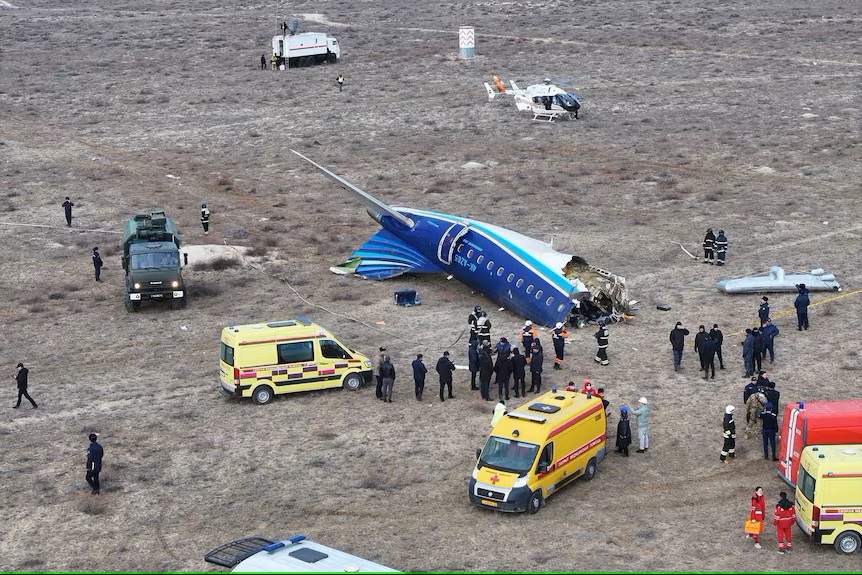|
Michael_Novakhov shared this story . |


A newly released transcript of radio communications reveals the tragic final moments of Azerbaijan Airlines Flight 8243, which crashed near Aktau on December 25, claiming 38 lives out of the 67 people on board. The transcript released by Telegram channel Baza reveals a cascade of technical failures and emergencies that developed during what should have been a routine flight from Baku to Grozny.
We will take you through the simplified cascade of events as it happened.
The flight first encountered issues at 7:37 AM Moscow time when the crew reported losing both GPS signals while nearing Grozny airport.
‘Grozny tower, Azerbaijan, 8-2-4-3, good morning, approaching flight level 130, both GPS lost, request vectoring for NDB approach.’
At 7:53 flight 8243 aborted their first attempt to land
‘Azerbaijan 8-2-4-3, going around, unstable approach……Requesting vectoring for go-around, Azerbaijan 8-2-4-3. GPS signal lost.’
At 8:01 the control tower lost visibility of the flight 8243 on their radar
Control Tower: ‘Azerbaijan 8-2-4-3, for your information, I do not see you on the radar, maintain current course and report removal.’
Flight 8243: ‘Current heading 0-8-0 degrees, distance to airport…8:02:00 E: 3-0 miles, but GPS signal lost, information may not be accurate.’
Efforts to conduct non-precision approaches using traditional navigation aids (NDB) were hindered by worsening weather, including visibility reduced to 3,300 meters and a cloud ceiling of 240 meters. After two failed landing attempts, the crew opted to abandon their efforts to land at Grozny and instead head back to Baku.
The situation however took a dire turn at 8:16 when the crew reported a bird strike, quickly followed by what they described as two explosions within the cockpit.
‘Grozny, the controls failed. Bird strike in the cockpit… Uh, bird strike and two seats exploded in the cockpit…….What is the weather like in Mineralnye Vody ( EDIT: an airport in Russsia), please help.’
The aircraft began suffering from a series of critical system failures, including:
-
Loss of flight controls
-
Hydraulic system failure
-
Steering malfunctions, forcing the crew to use engine throttles for directional control
-
Pressurization issues affecting the cabin system
8:18 ‘I can’t execute, control is lost Give us vectoring to Mineralnye Vody. And please give us the weather in Mineralnye Vody.’
8:19 ‘I can’t maintain 150, we have increased pressure in the cabin’
8:20 ‘…my plane is losing control. Give me Makhachkala ( EDIT: a city in Russsia)
8:22 ‘ Our hydraulics failed’.
At 8:28 the pilots decided to again return to Baku after receiving weather reports for both Baku and Makhachkala.
The crew informed the controller At 8:39, that while the engines were operational, the aileron and elevator control systems had failed and not long after that oxygen was low. The pilots decoded to divert once again, this time to Aktau in Kazakhstan.
At 8:52 this terrifying communication is heard
‘So, we have the following situation. We are running out of oxygen in the passenger cabin. So, an oxygen tank exploded there, I think. And, that means, there is a smell of fuel. And, some passengers… that means, they are losing consciousness. May I ask if we can go at a lower altitude?’
At 9:02, flight 8243 declared a MAYDAY emergency to Aktau Tower, reporting complete control surface failure and relying solely on engine throttles for control.
During the final approach to Aktau, the crew requested and were granted vectors for a straight-in approach to reduce the need for complex manoeuvres since they only had engine throttles for control. The airport was temporarily closed to other traffic, and runway lights were activated to assist the distressed aircraft. The transcript ends at 9:27 with the crew’s final communications as they approach Aktau airport.
Head over to our Instagram page to watch FLIGHTRADAR24’s playback of the flight which shows the vast amount of time that the airlin3 was not visible on radar
Azerbaijani officials and aviation experts concluded that the crash was caused by a Pantsir missile system, currently deployed by Russia to counter Ukrainian drones in the region. The confirmation followed reports from Azerbaijani media that shrapnel from a Russian Pantsir missile had struck the Embraer E190 as it approached Grozny.
Furthermore, Azerbaijani media reported that Russian electronic warfare systems disrupted the aircraft’s communication equipment, causing it to vanish from radar over Russian airspace and reappear near the Caspian Sea.
If you would like to read the full transcript you can find that here.
Get the latest news and updates straight to your inbox
No spam, no hassle, no fuss, just airline news direct to you.
No comments yet, be the first to write one.


